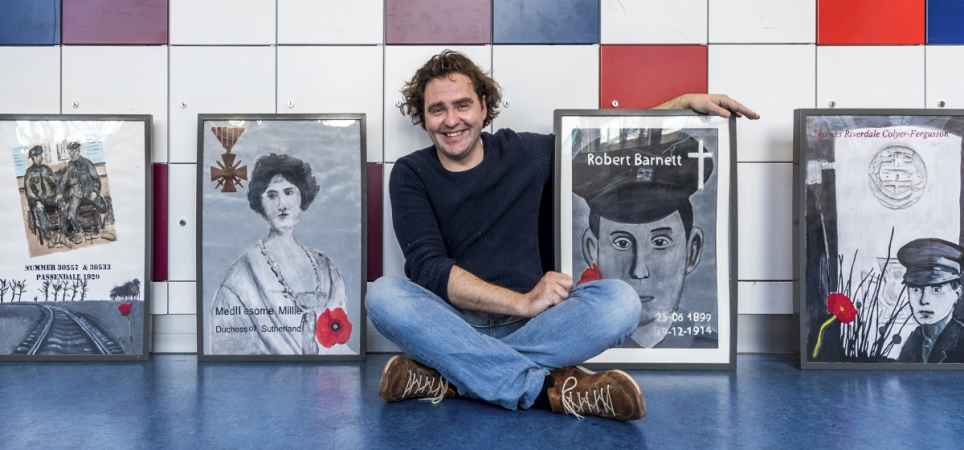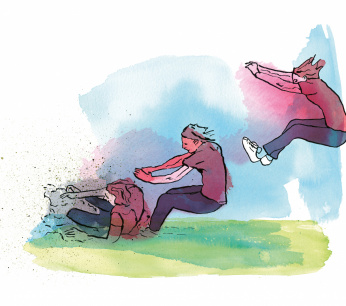VMBO students paint war victims
Vmbo students of teacher Jasper Nieuwenhuisen made portraits of WWI victims and were allowed to exhibit their paintings in Ypres, Belgium. "It became a joint adventure that no one will forget."

Image: Angeliek de Jonge
Joseph Stalin once said: 'One death is a drama, but 1 million are just statistics.' The trick is to bring those statistics to life.” Three years ago, Jasper Nieuwenhuisen, a visual arts teacher, changed his teaching program and asked his students to choose a victim from the First World War to make a portrait of. “When I told them how much the battlefields of Ypres had made an impression on me, they wanted to know more about it. But how do you visualize such a complex subject as the First World War, which had so many consequences?” Nieuwenhuisen, who works at the Assink Lyceum in Haaksbergen, decided to link the students to a victim, who was often only a few years older than them. "That's how you make it personal."
Love letter
The war museum in Ypres pointed the way to data on 43 war dead. Love letters or other documents are also available from some of them in addition to a black and white photo. Students used that information for their painting. Soldiers are depicted as cricket players, with the flag of their native country or with their pets. Student Manon Scharenborg chose nurse Nellie Splindler. "It is very sad how Nellie died," she writes in her report. She was tending to the wounded when a grenade hit her tent. I think it's very unfair how things went during the war. '
Fotoshop
First, the students made designs in photoshop, after which the final version was enlarged and they traced the most important lines on the canvas. “Painting is quite difficult for many students,” says the teacher. “By letting them trace those lines, you prevent everything from going out of proportion, with all the frustration that entails. Of course they want it to be a good portrait. ”
Our students were very annoyed by their French peers: why are they just standing here talking and looking at their cell phones, they asked
Especially when it became clear that they were allowed to exhibit their paintings in Ypres, near the Menin Gate memorial. In order to be able to go there themselves, the students collected money. “And so the project became wider and wider. The school gave me the space and also contributed financially. We left for Ypres with four colleagues. Only there you noticed how involved the students are. They were very upset about their English and French peers for whom the visit is a mandatory number. Why are they just standing here talking and checking their cell phones, they asked. ”
Morning dew
The students visited the graves where possible and left a flag behind. Some cried, but most became very quiet. 'When I was standing in front of the grave I closed a bit', Danny Sierhuis writes in his report. 'It was such a beautiful moment in the early morning with the morning dew still on the grass in a very empty cemetery. I felt good to have paid such a tribute. '
Nieuwenhuisen: “The moment they are there, the story becomes reality. A bond has formed that never existed before, almost as if it were family. Then it comes in hard. At the same time, they also realize what a beautiful world they are living in now. ”
Relatives
Pupils tried to trace relatives to donate the painting. In a few cases this worked. For example, the portrait of Lewis McGee now hangs in a town hall in a village in Tasmania. “The hotel owner I contacted immediately jumped on his bike to inform a distant great-nephew. The family wrote a wonderful thank you letter, really fantastic. ”
Another successful exhibition in Haaksbergen followed and the teacher received the Overijssel education prize for his project. According to him, the project can be carried out in any sector, and also in conjunction with other subjects such as history. The manual is already available on the special website. “I can recommend it to any teacher. I didn't have to drag the students along, they lifted me up. It became a joint adventure that no one will forget. Some students have even been back to the grave a few times. ”
For more information on Leftover.nl.
Each month the Education Magazine portrays a teacher or supporter who has developed an original idea. Are you working on something interesting, or do you know someone who fits in this series, let us know via education magazine @aob. Nl


